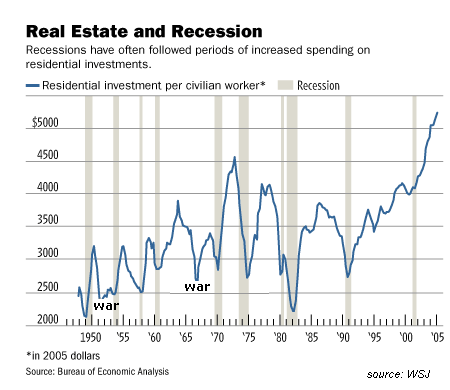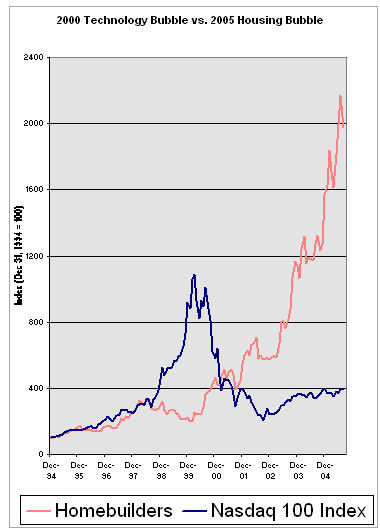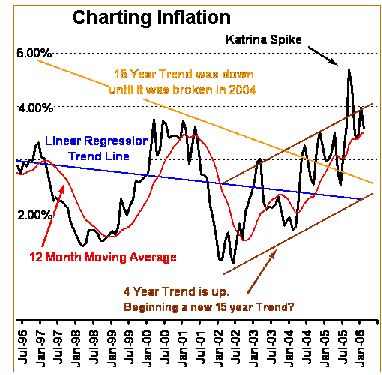

|
| weblog/wEssays archives | home | |
|
Where There Is Ruin, There Is Profit II (July 31, 2006) 
In response to last Wednesday's entry Housing Dominoes Fall, Correspondent Mark D. had this suggestion for a topic: How about an article on the variety of people who thrived after each domino fell?OK, I'll give it a shot. Let's start with this chart, which shows that over-investment in real estate (let's call it a massive mis-allocation of capital) is followed by recession. Is this causal or just bad luck? It's causal; over-investment in any sector produces diminishing returns as supply builds and demand is slaked. At some point, money dumped into the "hot" sector no longer returns a profit or positive cash flow; at that point it is mis-allocated because it would have earned a better return left in a savings account. This chart suggests the recession which will begin in the 4th quarter of 2006 or early 2007 will be a humdinger. Look at the last peak in 1972-73. Those of you alive during the ensuing recession recall that it was the most severe economic downturn since the Great Depression. The next spike of over-investment was followed by another devastating recession in the early 1980s. You can blame Iran or inflation or a host of other factors, but this chart strongly suggests that mis-allocation of capital in residential real estate sets up a very vulnerable economy.  The next chart suggests that the extremes of the housing bubble exceed those of the
dot-com era NASDAQ bubble, which in turn suggests that the severity of the coming decline might
also exceed that of the dot-bomb era wealth destruction.
The next chart suggests that the extremes of the housing bubble exceed those of the
dot-com era NASDAQ bubble, which in turn suggests that the severity of the coming decline might
also exceed that of the dot-bomb era wealth destruction.
Before we look at who thrived after similar dominoes fell in the past, read this disclaimer: There is no investment advice, or advice on anything in any way, shape or form, on this site. There is no advice, implied or otherwise, on this site. If you seek investment advice, please seek it elsewhere. There is none here. Thank you. In a related email on the domino effect, knowledgeable reader M.N. sent me a very thorough 20-point listing of factors in the coming hard landing for real estate. He also had these comments on profiting from the dominoes falling: I believe the investment potential here could be excellent. Between January and March this year I bought puts on some builders exposed to bubble zones which are up about 80%....but the real leverage may be in the 09 puts on some financial institutions.M.N. has already identified two types of people who profited after housing/recession dominoes fell: 1. People who bet against homebuilders and housing-related stocks (i.e. sold shares short or bought put options before the stocks declined) 2. Since housing's decline will hit lenders with foreclosure losses, those who bet against lenders profited from the housing domino's fall. Over at Rick's Picks, Rick foresees a day when Citicorp again trades for $5/share (currently it is $48/share). 3. After the U.S. consumer spending domino falls, those who bet against companies in the discretionary consumer spending sectors (restaurants, travel and leisure, etc.) thrived, as that sector dropped more than non-discretionary consumer spending (healthcare, etc.). 4. Since U.S. consumer spending is 20% of the global economy, those who bet against Non-U.S. companies which were dependent on sales to the U.S. consumer thrived. Since globalization, "peak oil" and massive U.S. currency account deficits are recent phenomena in the global economy, no one knows how a U.S. recession will affect commodities like oil or currencies like the dollar. As a result, we can only speculate using "if/then" statements: 5. If global oil demand remains high despite U.S. recession, then those holding oil and natural gas stocks may thrive. If global demand drops as a result of global recession, those betting on oil's decline will thrive. 6. If the dollar drops below 80, then other currencies and gold will likely rise and dollar-denominated bonds will fall in value. If the dollar strengthens, gold priced in dollars faces a headwind, and other currencies will fall against the dollar. 7. If inflation rises, interest rates will rise in unison, driving down the value of U.S. bonds. If deflation sets in, interest rates will likely decline, and the value of bonds will rise.  Over at
Mish's Global Economic Trend Analysis (recommended), esteemed blogger Mish makes
some very strong arguments for a long period of deflation somewhat akin to
Japan's 15-year decline from 1989 - 2003. If this scenario plays out, Mish suggests the
smart move would be to buy U.S. Treasury bonds now, as they will rise in value as interest
rates decline.
Over at
Mish's Global Economic Trend Analysis (recommended), esteemed blogger Mish makes
some very strong arguments for a long period of deflation somewhat akin to
Japan's 15-year decline from 1989 - 2003. If this scenario plays out, Mish suggests the
smart move would be to buy U.S. Treasury bonds now, as they will rise in value as interest
rates decline.
While Mish's arguments are compelling, it is also worth noting that interest rates and bonds tend to rise and fall in cycles of about 15 - 22 years. Since interest and bond rates hit bottom in 2003, some analysts (for instance, Louise Yamada Technical Research Advisors) suggest that rates and bonds are in the beginning stages of just such a 15-22 year up-trend. If this scenario plays out, then bonds will decrease in value as interest rates rise. No one knows which broad scenario will play out. There are good arguments for each line of thinking. The deflation scenario rests on the Japanese example, in which interest rates dropped to near zero but no one borrowed or spent much money, so demand dropped which caused prices to drop. The inflation/rising rates scenario rests on the assumption that developing-world growth in China, India and elsewhere will keep commodity prices for oil and foodstuffs high, driving global inflation even in stagnant economies. Other costs such as healthcare continue to rise in good times and bad, further adding to inflation. Regardless of which scenario is correct, here's an observation made by many veteran technical analysts, including Louise Yamada. At the true market bottom, the Dow Jones Industrials stock average (DJ-30) is roughly equal to an ounce of gold. In other words, at the market bottom in 1982, the Dow Jones was about 800, and gold hit $800 an ounce. No one knows if history will repeat, or echo, or simply gag and cough, but it's something to ponder. For more on this subject and a wide array of other topics, please visit my weblog. copyright © 2006 Charles Hugh Smith. All rights reserved in all media. I would be honored if you linked this wEssay to your site, or printed a copy for your own use. |
||
| weblog/wEssays | home |